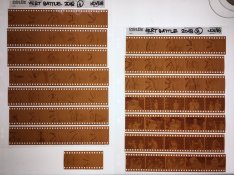My apologies if I missed anything in this fairly elaborate thread. I picked the above post because it reflects quite closely my curiosity that I had a little while ago.
Essentially, I was intrigued by Cinestill film, decided I would rather use the original Vision3 stock, but I also wanted to be able to make passable RA4 prints here at home. I got some Vision3 50D (35mm) and first tried the often-used route of C41 development. This resulted in fairly high contrast negatives, but moreover uncorrectable/skewed color balance. Even scanned negatives required an in my eyes unacceptable amount of trickery in PS to get them right - and I wasn't looking for a PS exercise to begin with.
I therefore resorted to cobbling up an ECN-2 developer based on what I could find online in terms of formulae, adapted to the materials I had lying around anyway. The resulting developer works, but it does not conform to any official specification. However, it seems to work quite alright for what I want it to do.
Due to the lower gamma of ECN-2, I decided to overexpose the film by 2/3 stop (so E.I. 32 instead of the 50 ISO box speed) in order to preserve shadow detail.
Here are some sample scans from RA4 prints made from Vision3 50D negatives, developed in my homebrew ECN-2 chemistry:
Both above on Fuji Crystal Archive II (a paper I will not buy again due to problems getting even, deep blacks). If true blacks are missing in the images above, keep in mind this is an artifact of the digital scans; the prints themselves occupy the full density range of the paper.
These are from the same film stock on Kodak Endura F, which seems to give more saturation, although the lighting conditions were also different (natural afternoon late-summer sunlight as opposed to studio strobes in the portraits above):
All RA4 prints developed in Fuji Hunt MP90 RA4 developer at room temperature.Filtering was, if I recall correctly, a little outside the regular 'box' of C41 films, requiring more yellow filtering than C41 films (something like 10-20CC if memory serves).
The ECN-2 chemistry I used consisted of a DIY developer, a ferricyanide bleach and a regular C41 fix. I also used a remjet removal bath (borax/sulfite/sodium hydroxide) and a few rinse baths (with vigorous shaking) prior to development. I wiped the negatives after processing with my fingers to remove a very slight remaining veil of carbon particles from the remjet layer. The formulas I used are below:
Remjet removal bath:
Borax: 20g/l
Sodium sulfite: 100g/l
Sodium hydroxide: 1g/l
ECN-2 developer:
Sodium sulfite: 2g/l
Potassium bromide: 1.4g/l
Sodium carbonate decahydrate (AKA cleaning soda): 68.8g/l
Sodium bicarbonate: 2.7g/l
CD3: 4g/l
Bring pH up to 10.25 using sodium hydroxide 10% solution
Stop bath:
Sulfuric acid 37% (AKA battery acid): 10ml/l
Ferricyanide bleach:
Potassium ferricyanide: 40g/l
Potassium bromide: 25g/l
Fixer was a regular C41 fixer from a Rollei Digibase kit; any roughly pH neutral fixer should work as far as I can tell.
Processing steps were as follows:
Remjet removal bath: 1 minute; temperature not critical
Power-rinse (fill tank, shake vigorously): ca. 30 seconds, temperature not critical; repeat 3 times until wash water is perfectly clear (pink dyes will also wash out during this step and in the remjet removal bath).
Developer: 3min 15 sec. @ 41.1C Jobo CPE2 slow rotation speed (ca. 30rpm IIRC)
Stop: 30 seconds @ 27-41C
Wash: 30 seconds @ 27-41C, repeat 3 times
Bleach: 3 minutes @ 38C (not critical)
Wash: 30 seconds @ 27-41, repeat 3 times until wash water does not contain the least trace of yellow from the bleach bath
Fix: 2 minutes @ 38C (longer fixing doesn't hurt; use C41 fixing times if so desired)
Wash thoroughly.
I did not use a conditioner or stabilizing bath, but I understand this could be wise for long-term storage. Especially for these test negatives I was not very concerned about long-term stability and I have to be frank in that I usually don't really bother about that. Hence, by non-professional DIY approach works well enough for me, but may not suit the requirements of more strict darkroom workers.
Overall, the process seems to yield negatives that can be used to make (for me) satisfactory prints with fairly neutral colors. Contrast is on the low side, but this is exactly what I was looking for, since RA4 papers tend to give rather contrasty images anyway and for e.g. portraiture, a more low-contrast look is sometimes desirable. I have not tried any pushing or pulling with ECN-2 (yet).















